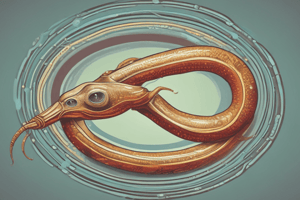Podcast
Questions and Answers
What is a significant reaction associated with immediate hypersensitivity type 1?
What is a significant reaction associated with immediate hypersensitivity type 1?
- Thrombocytopenia
- Anemia
- Leukopenia
- Hypereosinophilia (correct)
What organ is primarily affected by verminous pneumonitis in this context?
What organ is primarily affected by verminous pneumonitis in this context?
- Kidney
- Stomach
- Lung (correct)
- Heart
During the migration stage of immature worms, which combination of organs is noted to have hyperplasia?
During the migration stage of immature worms, which combination of organs is noted to have hyperplasia?
- Liver and spleen (correct)
- Lungs and heart
- Pancreas and thyroid
- Brain and kidneys
What time frame is associated with the migration stage of young immature worms?
What time frame is associated with the migration stage of young immature worms?
Which symptom is characteristic of the acute febrile reaction due to worm migration?
Which symptom is characteristic of the acute febrile reaction due to worm migration?
What is a potential consequence of metabolic byproducts related to acute schistosomiasis?
What is a potential consequence of metabolic byproducts related to acute schistosomiasis?
When do systemic hypersensitivity reactions typically occur after schistosomiasis infection?
When do systemic hypersensitivity reactions typically occur after schistosomiasis infection?
What is another name for acute schistosomiasis?
What is another name for acute schistosomiasis?
Which of the following best describes acute schistosomiasis?
Which of the following best describes acute schistosomiasis?
What is a significant factor in the pathophysiology of acute schistosomiasis?
What is a significant factor in the pathophysiology of acute schistosomiasis?
Which morphological feature is characteristic of the adult stage of Schistosoma mansoni?
Which morphological feature is characteristic of the adult stage of Schistosoma mansoni?
What is the correct sequence of the life cycle stages of Schistosoma mansoni?
What is the correct sequence of the life cycle stages of Schistosoma mansoni?
Which stage of Schistosoma mansoni is typically free-living in the environment?
Which stage of Schistosoma mansoni is typically free-living in the environment?
In which stage does Schistosoma mansoni reproduce sexually?
In which stage does Schistosoma mansoni reproduce sexually?
What is a key morphological feature of the cercarial stage of Schistosoma mansoni?
What is a key morphological feature of the cercarial stage of Schistosoma mansoni?
What condition is associated with massive splenomegaly due to portal hypertension?
What condition is associated with massive splenomegaly due to portal hypertension?
What is the primary cause of pancytopenia in the context of hypersplenism?
What is the primary cause of pancytopenia in the context of hypersplenism?
Which of the following is a consequence of congestive splenomegaly?
Which of the following is a consequence of congestive splenomegaly?
What is a potential impact on blood cells due to massive splenomegaly?
What is a potential impact on blood cells due to massive splenomegaly?
Which factor contributes to the atrophy of lymphoid follicles in the spleen due to hypersplenism?
Which factor contributes to the atrophy of lymphoid follicles in the spleen due to hypersplenism?
What condition is characterized by perivascular infiltration around trapped eggs?
What condition is characterized by perivascular infiltration around trapped eggs?
Which pathological change can lead to the obstruction of portal blood flow?
Which pathological change can lead to the obstruction of portal blood flow?
Which condition is commonly associated with portal hypertension?
Which condition is commonly associated with portal hypertension?
What type of lesions are caused by diffuse inflammation in the context described?
What type of lesions are caused by diffuse inflammation in the context described?
What is likely to occur as a result of prolonged portal hypertension?
What is likely to occur as a result of prolonged portal hypertension?
Study Notes
Schistosoma mansoni: Morphological Features
- Cercaria: The larval stage of Schistosoma mansoni, with a tail for swimming and a penetrating spiny head.
- Schistosomula: The larval stage that emerges after the cercaria penetrates the host's skin, without a tail, ready to migrate through the body.
- Adult Worm (Male): Elongated, with a ventral groove that accommodates the female, often darker than the female.
- Adult Worm (Female): Longer and thinner than the male; capable of laying thousands of eggs.
Schistosoma mansoni: Life Cycle
- Cercaria penetrates human skin: Infection starts with the cercaria stage, which penetrates through the skin.
- Migration through the body: The cercaria then morphs into a schistosomula, migrating through the bloodstream to the lungs.
- Maturation: The schistosomula continue their journey to the liver, where they mature into adult worms.
- Mating: Once mature, the female becomes fertilized by the male and lays eggs.
- Egg deposition in the intestinal wall: The eggs are released by the female and migrate to the intestines, eventually reaching the lumen and being excreted in feces of the human host.
- Release of eggs: Eggs in the water develop into miracidia, which infect snails.
- Snail infection: Miracidia multiply in snails, turning into cercariae, which can then escape and infect humans.
Schistosoma mansoni: Migration Stage
- Migration of young worms: Immature worms migrate through the body, causing inflammation and hypersensitivity reactions.
- Acute febrile reaction: This migration often leads to a fever, hypereosinophilia (high eosinophil count)
- Organ-specific inflammation: The migrating worms can target the lungs (verminous pneumonitis), liver (hyperplasia), and spleen (hyperplasia).
- Metabolic byproducts contribute: The metabolic byproducts from the worms also provoke toxic and allergic reactions, leading to acute schistosomiasis (Katayama fever).
Schistosomiasis: Clinical Presentation
- Systemic hypersensitivity reaction: This condition can develop 2-8 weeks after initial infection, characterized by a strong immune response to the worms.
- Massive splenomegaly: The spleen can become enlarged due to increased blood flow associated with portal hypertension caused by the worm infestation.
- Pancytopenia: A decrease in all blood cell types can occur due to hyperplasia of red blood cells and atrophy of lymphoid follicles in the spleen.
- Granulomatous nodules: Trapped eggs in the host tissue initiate an inflammatory reaction, leading to the formation of granulomatous nodules and diffuse lesions around the blood vessels.
- Periportal fibrosis: Scarring can occur around the portal veins in the liver due to chronic inflammation, leading to a narrowing of the vessels.
- Obstruction of portal blood flow: The scarring can obstruct the flow of blood through the portal vein, contributing to portal hypertension.
Studying That Suits You
Use AI to generate personalized quizzes and flashcards to suit your learning preferences.
Related Documents
Description
Discover the fascinating details of Schistosoma mansoni, including its morphological features and complex life cycle. This quiz covers the various stages from cercaria to adult worm, highlighting key characteristics and processes involved in its transmission and maturation.




